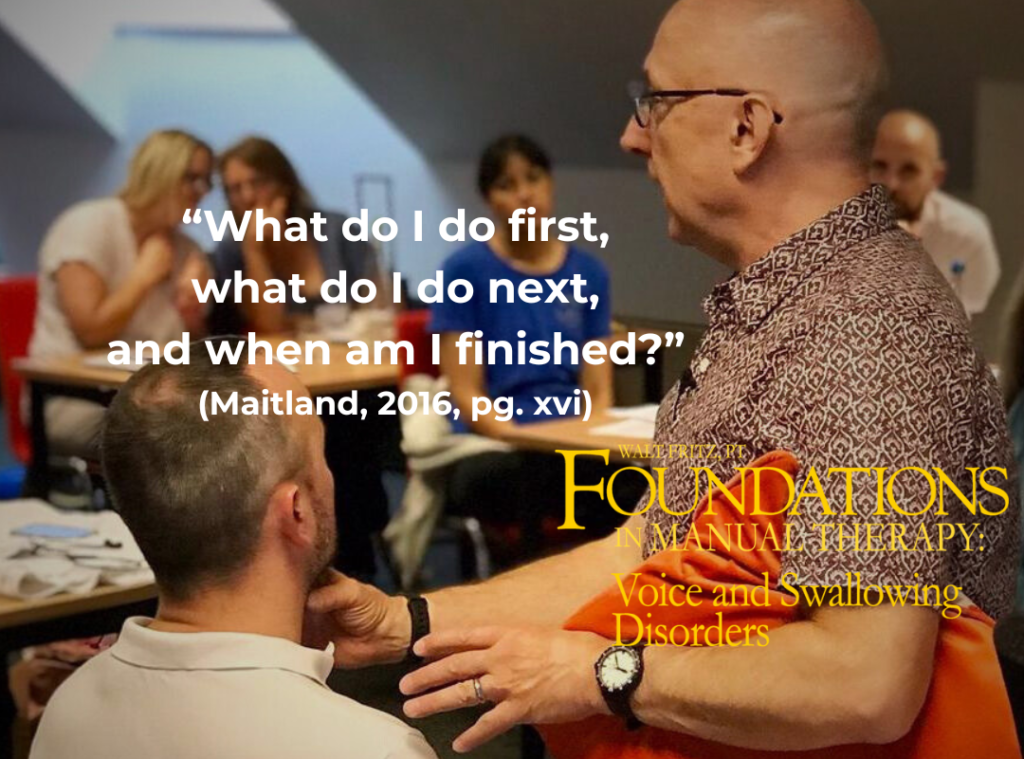“What do I do first, what do I do next, and when am I finished?”
Walt Fritz, PT/Foundations in Manual Therapy: Voice and Swallowing Disorders

The touch-based, shared decision-making model of manual therapy I teach to speech-language pathologists and others is relatively simple, yet some find it complex. It seems complicated to those expecting me to teach them a tissue pathology story and how to intervene to correct that problem directly. Things get confusing at this point, as I avoid giving them what they want and expect (i.e., target the muscle tension, correct their posture, balance their pelvis, etc.). Yet the work is simple: touch in a manner the patient feels is helpful. Allow the patient to determine the intervention, or at least with your input. Simple, right?
Over the years I’ve been teaching my Foundations in Manual Therapy: Voice and Swallowing Disorders class, my answers to the questions posed above were common. I’m known to be somewhat vague, saying things like “allow the patient to determine what you do,” “ask them what feels helpful,” and “start where they tell you their problem lies.” My vagueness irritated some learners, while others stayed the course, allowing a process to unfold that patients truly can guide. Those who stuck with it realized that despite many insisting otherwise, one could not target a specific tissue for intervention. We treat patients, not tissues. My approach is about working with a patient and their values and expectations.
Recently, while waiting at a medical appointment, I began reading Jeffrey Maitland’s book, Embodied Being, The Philosophical Roots of Manual Therapy. I didn’t get past the foreword before being called into the examination room, but in that foreword (by Judith S. Freilich, MD), I read:
“The complicated process of designing treatment strategies is boiled down to answering three simple questions: What do I do first, what do I do next, and when am I finished?” (Maitland, 2016, pg. x) Maitland himself discusses those questions later in the book (pg. xvi).
I spent some time rolling over those questions while at that appointment and realized I may have missed the mark with learners seeking more clarity on the process. Hungry for guidance, I avoided giving; I may have turned off many who could use my work to benefit others. It’s time for a mea culpa: I am at fault. These concepts will be at the forefront of my presentations. I will continue to push others towards treating the patient’s perspectives rather than treating what we think is essential, but I will now provide a framework for that process.
What do I do first?
Explain to your patient the process and their place in it. Tell them you are looking to use touch to connect them to their issue, and without their help, you stand less of a chance in helping. Your hands will be placed at or near where they experience the problem (if possible). Together, you will both begin to explore, including having them put their hands over yours to guide you towards an optimal area of sensation. Work until their eyes show that light that you’ve connected them to their issues. Treatment quickly follows this evaluation, as when you’ve made that connection, you’ve already begun the intervention.
What do I do next?
The time spent in a manual therapy “hold” seems crucial; at least, it did when I worked from a historical myofascial release model. If the “release” weren’t held for X seconds or minutes, changes would not last. But compare that story with others, and confusion sets in, as most models use a different time frame as “necessary.” Hold times in studies vary as well. Bitnar et al. (2021) showed that upper and lower esophageal pressures could be normalized in patients with GERD through a two-step manual therapy technique where the hold times were only 30 seconds 2. Given the seeming lack of clarity for the exact length of time sustained manual therapy interventions should be held, I switch the decision-making over to the patient. The thing to do next is to allow your patient to guide you.
One question I’m fond of is, “Does it feel that we are spending our time in a way that seems productive?” Allow them to adjust your pressures, take a rest, get you to push harder or softer, or switch to another activity. Manual therapy should never be a standalone intervention. Instead, it should be embedded into the larger framework of your profession. I incorporate movement through the session, remembering that the goal is not to release the tissues but to habilitate the patient into a more normal lifestyle.
When am I finished?
You are done with the manual therapy portion of the intervention when your hands get tired when your patient says they’ve had enough, when you know you’ve got other things you want/need to include in the session, or when the clock says, “times up!”
Reading (and following through on) this simple passage has been a big lesson for me in translating my concepts to others and one I know will continue to evolve and unfold. This work is both simple and complex. Apply contextually-appropriate touch in an area of patient concern and try to match your touch (pressure, direction and depth of stretch, etc) and allow them to create their change. However, working with the lived experiences of another creates a complex tapestry of options and possibilities. Newcomers tend to get overwhelmed, but patience and consistent handing over to the patient the responsibility for decision-making eases this burden.
Walt Fritz, PT
Foundations in Manual Therapy: Voice and Swallowing Disorders
- Maitland, J. (2016). Embodied Being: The Philosophical Roots of Manual Therapy. Berkeley: North Atlantic Books, pg. x, xvi.
- Bitnar, P., Stovicek, J., Hlava, S., et al. “Manual Cervical Traction and Trunk Stabilization Cause Significant Changes in Upper and Lower Esophageal Sphincter: A Randomized Trial.” Journal of Manipulative and Physiological Therapeutics 44(4) (2021): 344-351.

Sorry, comments are closed for this post.